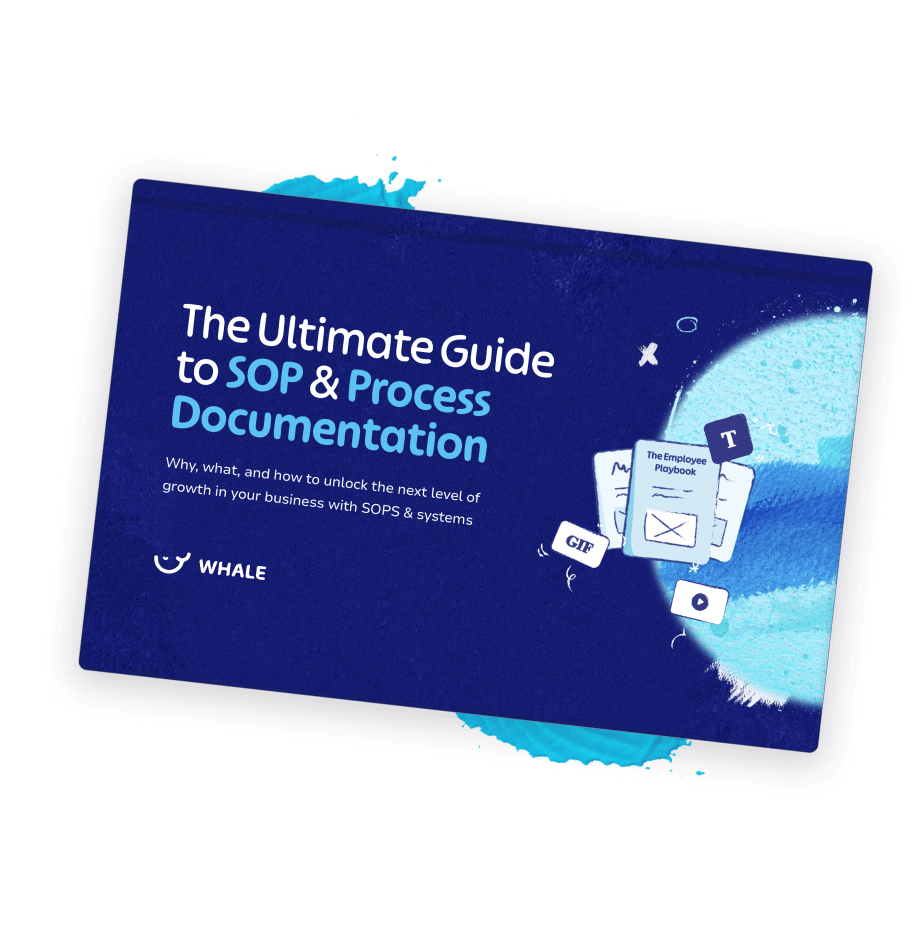Why would you need SOPs for digital transformation? And what is digital transformation anyway?
In today’s fast-changing business world, going digital is crucial for companies to stay
competitive. Digital transformation means using technology to improve different parts of your business, like making things more efficient and giving customers better experiences.
For example, Consider a traditional retail store looking to adapt to changing consumer preferences and the rise of online shopping. In the past, they may have relied on physical stores and traditional advertising methods. However, to keep up with changing consumer preferences and the rise of online shopping, they decide to embrace digital transformation.
They start by creating an e-commerce website or redesigning the existing site where customers can browse and purchase products online. They integrate their online and offline inventory systems, allowing customers to check product availability in real-time. They also implement digital marketing strategies such as social media advertising and personalized email campaigns to reach a wider audience and engage with customers.
Additionally, they introduce digital payment options, enabling customers to make secure online transactions. They invest in customer relationship management (CRM) software to better understand their customers’ preferences and offer personalized recommendations.
In this way, the company can become more customer-centric and data-driven.
But bringing in digital changes can be complicated without a well-defined plan. In this article, we will guide you on how to build an effective Standard Operating Procedure (SOP) that will facilitate a smooth and successful digital transformation implementation. It focuses on providing guidance for developing an effective SOP roadmap that enables seamless implementation of digital transformation initiatives. The goal is to ensure that your company has clear processes in place to support its digital transformation efforts.
Why use SOPs for digital transformation?
When it comes to digital transformation, SOPs play a crucial role in facilitating and managing the transition effectively. Here are some reasons why SOPs are valuable in the context of digital transformation:
Process Alignment: Digital transformation involves implementing new technologies and redefining existing processes. SOPs help align the digital initiatives with the organizational goals and ensure that the transformation efforts are consistent with the overall business strategy.
Consistency and Standardization: SOPs establish a set of guidelines and best practices that all employees can follow. They define the standardized procedures for carrying out specific tasks or workflows, minimizing variations and ensuring consistency across teams and departments. This is particularly important during digital transformation, as it often involves integrating different systems and processes.
Change Management: Digital transformation often requires changes in technology, workflows, and organizational structure. SOPs provide a structured approach to manage these changes. They outline the step-by-step procedures for implementing new technologies, training employees, and addressing potential challenges, helping to mitigate resistance and ensure a smoother transition.
Knowledge Transfer: Digital transformation initiatives may involve the introduction of new technologies and processes, which require employees to acquire new skills and knowledge. SOPs act as a knowledge transfer mechanism by documenting the new processes and providing employees with a reference point to understand and execute their tasks effectively.
Risk Mitigation: Digital transformation can introduce new risks and challenges. SOPs help identify and address potential risks associated with the implementation of new technologies or changes in processes. By documenting procedures and incorporating risk management measures, SOPs help minimize the chances of errors, data breaches, or operational disruptions.
Continuous Improvement: Digital transformation is an ongoing process, and organizations need to continuously refine and optimize their digital capabilities. SOPs provide a foundation for continuous improvement by capturing feedback, identifying bottlenecks, and suggesting improvements to the existing processes. They facilitate a cycle of review, refinement, and update, enabling organizations to adapt to changing needs and technologies.
How to develop SOPs for digital transformation; An effective roadmap
Here are several tips on how to develop an efficient SOP roadmap to be able to have a
seamless and successful implementation of digital transformation:
1. Understand the goal
In this initial step, it is crucial to thoroughly comprehend the overall objectives of the
organization and how digital transformation aligns with these goals. By having a clear
understanding of the desired outcomes, you can better tailor the SOP to meet the
specific needs of the organization. These objectives could vary depending on your
organization’s unique needs and priorities.
For instance, you might aim to simplify your internal processes by automating manual tasks and improving workflow efficiency. This can lead to cost savings, increased productivity, and streamlined operations.
2. Establish a Digital Transformation Team
When establishing a digital transformation team, assessing the resources available within the company is essential. This assessment helps determine if the organization has the necessary capabilities internally to drive digital transformation effectively. If the company lacks the required expertise or resources, it may be worth considering outsourcing certain digital services.
Outsourcing can involve partnering with external professionals who specialize in digital transformation to complement the internal team’s capabilities and ensure a successful implementation. By carefully evaluating the available resources, organizations can make informed decisions about leveraging external expertise when necessary.
Hint – don’t forget to make technology part of your digital team! Although technology is part of the process of change, it can also be instrumental in assisting with certain tasks.
3. Conduct a Detailed Assessment
Conducting a thorough evaluation of the current processes, systems, and technologies
is really important. This assessment is like a big check-up that helps you identify the
areas that need some improvement or digitalization.
Conder areas such as
- Strategy and company leadership
- The current technology stack
- Operations
- Customer experience
- Company culture
It’s like shining a light on the places that could use some upgrades or changes to make them work even better. Try to also uncover any risks or challenges that might
pop up during the transformation. By figuring out what could go wrong, you can come up with clever plans to overcome those obstacles and keep things running smoothly.
4. Conduct a Stakeholder Analysis (Basically understand how people will be impacted)
Digital transformation impacts various stakeholders within your organization, including employees, customers, and partners. Conducting a thorough stakeholder analysis
allows you to understand their needs, concerns, and expectations regarding digital
transformation.
Engaging stakeholders from the early stages of the process is crucial for building support, alignment, and ownership of digital transformation initiatives. Regular communication, training programs, and workshops can be employed to foster awareness, involvement, and collaboration among stakeholders.
5. Establish a Realistic and Achievable Timeline
Creating a well-structured timeline with clearly defined milestones and deadlines is
imperative. This timeline acts as a roadmap, guiding the implementation process and
helping to manage expectations. By setting realistic timelines, you can ensure that the
transformation progresses smoothly without unnecessary delays or disruptions.
Hit – You’ll want to use your SMART rocks here!
6. Develop Comprehensive Standard Operating Procedures (SOPs)
This step involves a thorough review and documentation of existing processes and
workflows within the organisation. By carefully analysing these processes, you can
identify areas that require the development of new or revised SOPs to align with the
digital transformation goals. The SOPs should be comprehensive, providing clear and
detailed guidelines to ensure consistency and efficiency in operations.
7. Test, Gather Feedback, and Continuously Improve
Conducting pilot tests of the new SOPs in a controlled environment allows for the
identification of any potential issues or areas for improvement. During this phase, seek feedback from users and stakeholders to refine and enhance the SOPs based on real-world experiences. Embrace a culture of continuous improvement, regularly evaluating and adapting the SOPs to meet evolving business needs.
8. Change Management and Training
Change management and training go hand in hand with developing and implementing
an efficient Standard Operating Procedure (SOP) during a digital transformation.
Change management focuses on helping employees navigate and embrace the
changes brought about by the digital transformation. By addressing their concerns,
communicating the benefits, and involving them in the process, organisations can foster
a positive attitude towards change.
When combined with an efficient SOP, change management ensures that employees understand the new processes and are ready to implement them effectively. Alongside change management, training programs play a critical role in equipping employees with the necessary skills to operate within the new digital landscape. Training focuses on educating employees on the specific processes outlined in the SOP.
9. Implement, Monitor, and Evaluate
Once the SOPs are finalized, they can be implemented organization-wide. Continuous improvement and evaluation are essential components of a successful digital transformation. It involves regularly assessing and refining the implemented digital processes and SOPs through evaluation and continuous improvement, organizations foster a culture of innovation and learning.
By encouraging employees to share their insights and ideas for improvement, organizations can uncover opportunities for innovation and growth. By analysing data and feedback, organisations can make informed decisions about the next steps in their digital transformation journey.
This data-driven approach reduces risks and increases the chances of success.
Bottom Line?
In a nutshell, developing and implementing an effective Standard Operating Procedure (SOP) is crucial for facilitating a smooth and successful digital transformation.
Embracing SOPs as a foundation helps embrace technological advancements, streamline operations, and deliver enhanced customer experiences.
By following the tips outlined in this article, organizations can ensure that their SOP supports the transformation process and maximizes its benefits.
Ultimate Guide to SOP & Process Documentation
The why, what, and how to unlock the next level of growth in your business with SOPS & systems











